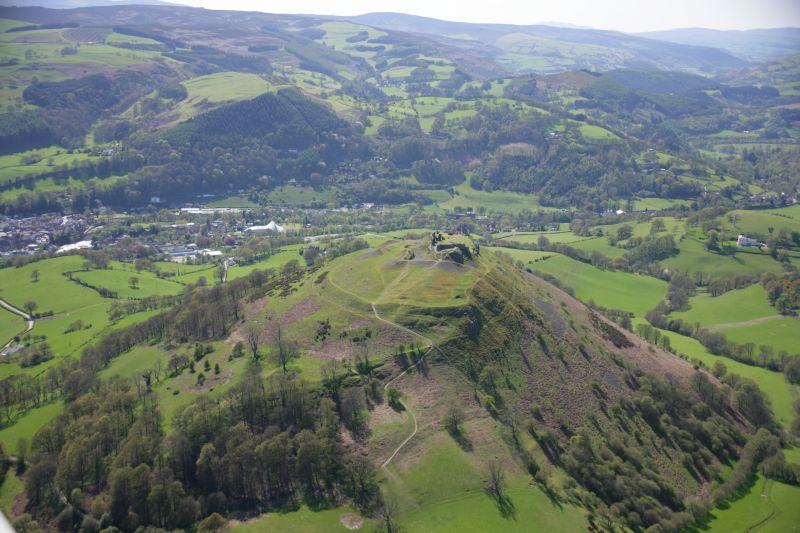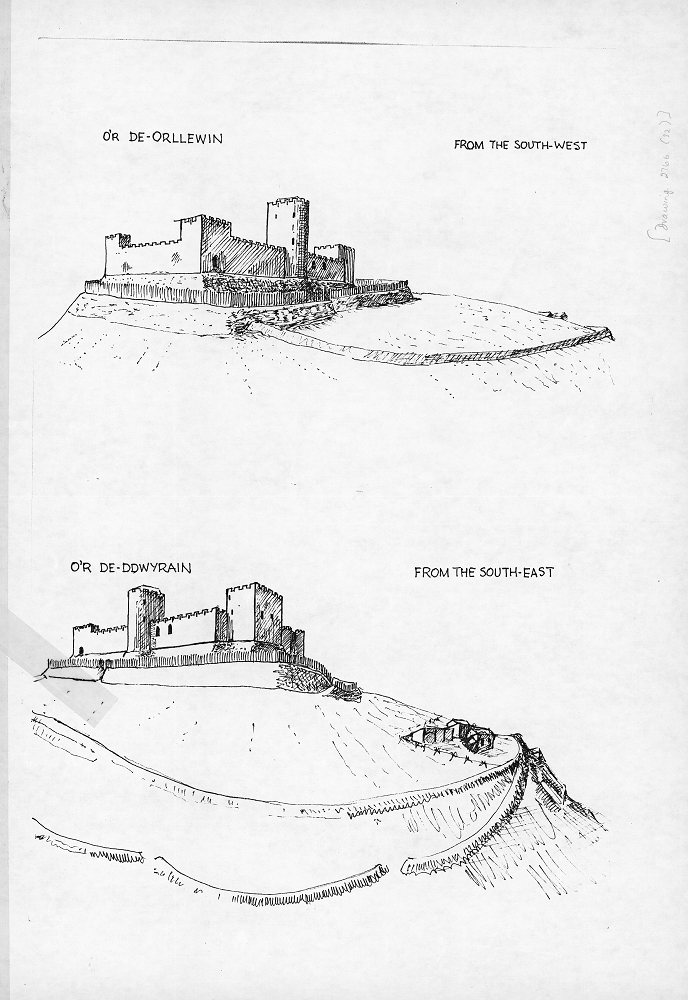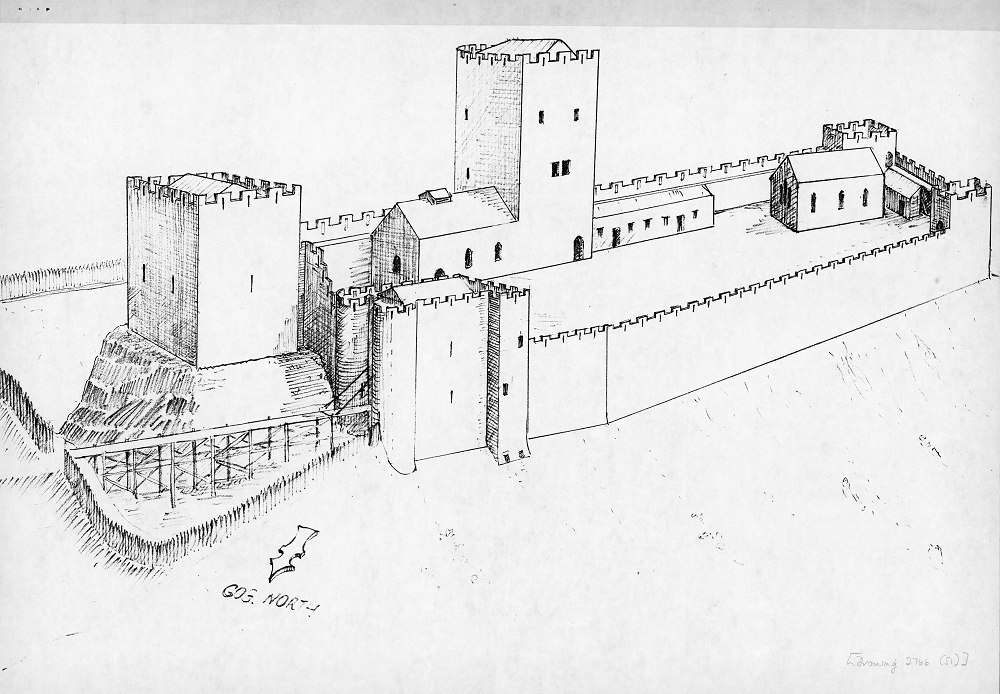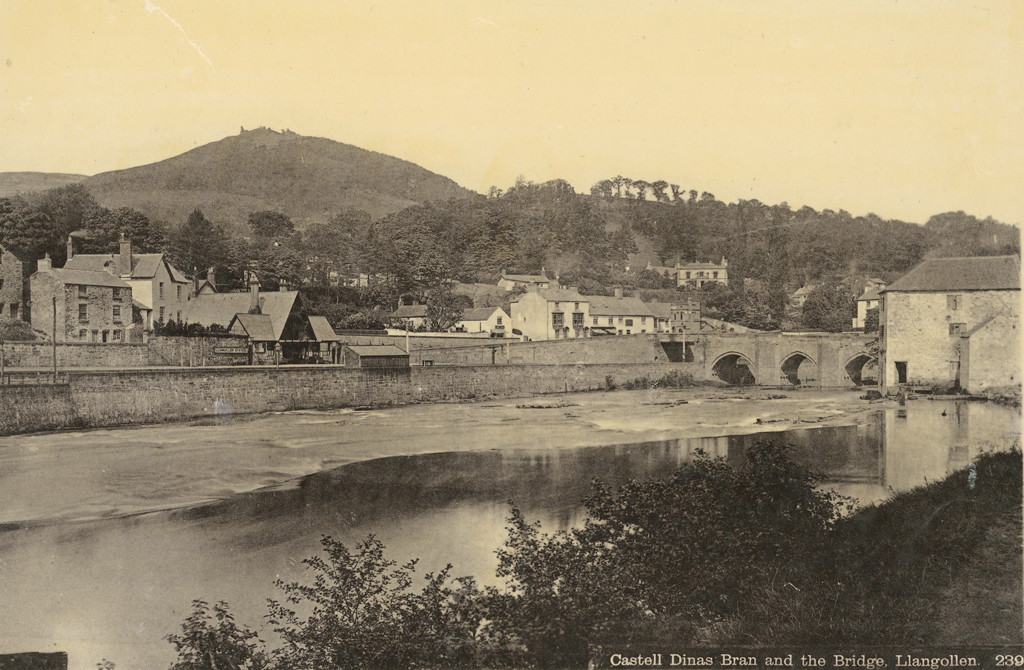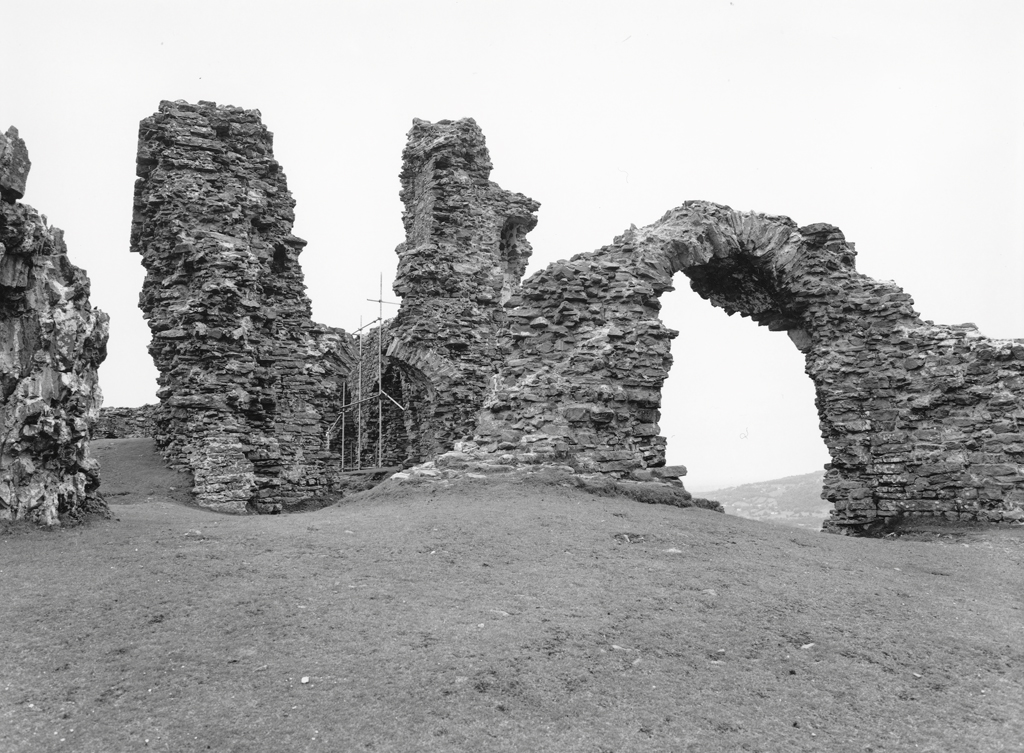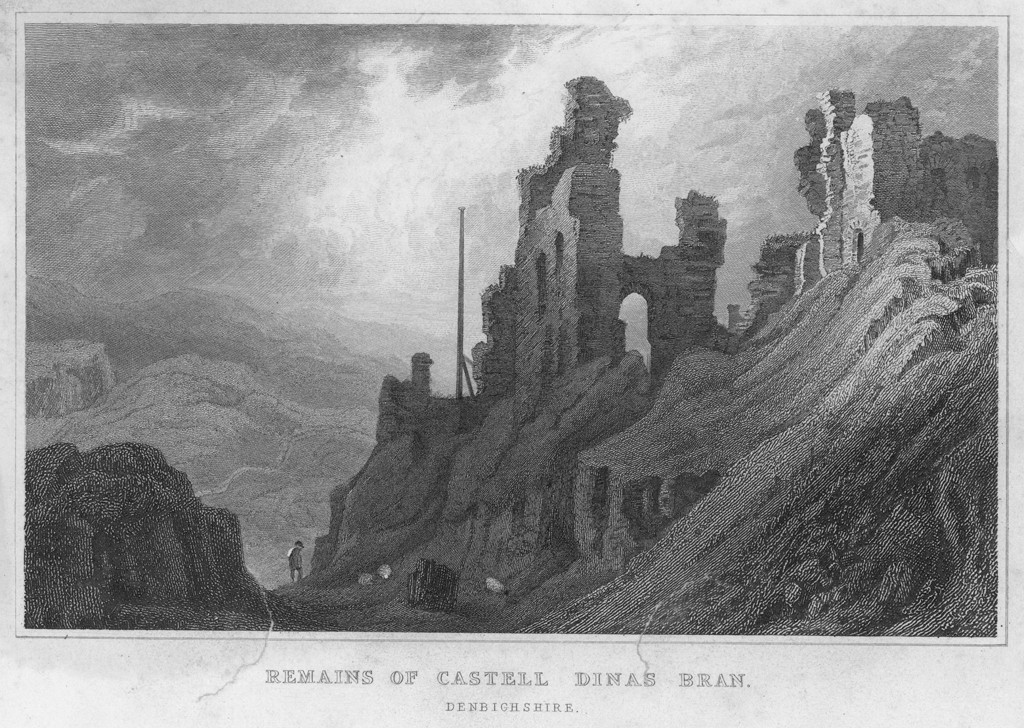Castell Dinas Brân - Overview
The ruins of this medieval castle sit atop a prominent hill on the outskirts of Llangollen. The site originates with an Iron Age hillfort. Documentary evidence suggests the Princes of northern Powys built a timber castle here in the late twelfth century, but it burnt down without trace. It was probably Gruffudd ap Madog, son of the founder of nearby Valle Crucis Abbey, who rebuilt the castle in stone c.1270, but much like its predecessors, this third and last castle did not last long. When Henry de Lacy, commanding troops on behalf of King Edward I, approached in 1277, the Welsh defenders of the castle set fire to it so that it would not be of subsequent use for the invading English armies. The damage was not excessive as Edward I briefly garrisoned forces here, but the site was abandoned after Holt castle was built as the new centre of the Lordship after Llewelyn ap Gruffudd’s death in 1282.
According to legend, the Welsh princess Myfanwy Fychan lived at this castle and inspired the Welsh bard Hywel ab Einion to compose his famous ode in which he pines for her love. By the time the poem was written, Castell Dinas Brân had lain in ruin for quite some time and Myfanwy had married the nobleman Goronwy ap Tudur Hen, Lord of Penmynydd. It is said that this poem inspired the poem ‘Myfanwy Fychan’ by John Ceiriog Hughes as well as Richard Davies’ lyrics to the popular song ‘Myfanwy’, composed by Joseph Parry.
By the dawn of modern tourism, Dinas Brân was a spectacularly picturesque ruin sitting atop an exposed hill. Its proximity to Llangollen, situated on the historical main road through the north of Wales, ensured the ruins featured prominently in many travellers’ descriptions and drawings.
With assistance from Cadw, Castell Dinas Brân is now taken care of by Denbighshire County Council.
Accounts of Travel
Nordland-Fahrten. Zweite Abteilung, c. 1870s
Franz Brömel (1829 – 1904)
Von Llangollen führt der Weg nach Dinas Bran auf angenehm gewundenem Pfade, angesichts der Wasser des „dunklen heiligen Dee“, eines Flusses dessen noch heute auf jeder wälischen Harfe gedacht wird. Wohl an zwei Tausend Fuß geht es aufwährts. Dinas Bran ist recht eigentlich von Feind und Zeit zerstampft. Ein Kreis von Steinklumpen, kaum noch eine Bauform verratend, ist Alles, was übrig geblieben, ein einziges Thor, oder nur das steinerne Gerippe eines solchen bildet einen alterthümlichen Rahmen für die Fernschau weit hinaus über öde, stille Berge und über einen fernem weißen Bahnviadukt hinweg auf ein ebenes Hochplateau, abgeschlossen am Horizont von dämmerigen Bergen. Zu Dinas Bran, das sein Baujahr in das siebente Jahrhundert zurückführt, wohnte dereinst als erste Insassin das Schlosses eine wegen ihrer Schönheit und Wandelbarkeit berühmte Prinzessin, mit Namen Myfanwy „die viele Herzen gebrochen“, darunter auch das eines Poeten Hywel ab Einion Llygliw, dessen Minnelieder die Barden aufbewahrt haben. Eines beginnt:
Kalt schauet der Mond auf dein Haus, Dinas Bran,
Und traurig murmelt der dunkle Dee!
Um mein Leben, meine Lust, mein Licht ist’s gethan,
Aus den Fluthen des Grames erheb‘ ich mich nie!
Und doch war mein Liebeslenz wundersam licht
Und Hoffnung winkte mir sonnenwärts!
Doch Myfynwy ist kalt und erhört mich nicht,
Meine Harfe, mein Himmel nur hören mein Herz!
Dem Liede merkt man seine zwölfhundert Jahre nicht an – es sind die uralten, ewig jungen Gefühle! Hywel schließt mit einem Aufruf an die Barden der Zukunft „seine Thränen in ihren Harfenkränzen heilig zu halten“ und damit noch „ungeborenen“ Schönen „Entzücken“ zu bereiten! Nicht ohne Anklang von Satyre ist diese Wehmuth!
The way from Llangollen to Dinas Bran leads along a pleasantly winding path besides the waters of the ‘dark holy Dee’, the river commemorated by every Welsh harp to this day. We climb about two thousand feet. In truth, Dinas Bran has been pounded by enemies and time. A circle of stone clumps hardly betraying any design is all that remains; a single gateway, or rather the stony scrag of one, provides an ancient frame for the distant view across barren, silent mountains, over a distant white rail viaduct and an even plateau which are enclosed by dusky mountains on the horizon. In Dinas Bran, which traces its year of construction back to the seventh century, once lived as its first inhabitant a princess named Myfanwy, famed for her beauty and changeableness, ‘who broke many hearts’, among them the heart of the poet Hywel ab Einion Llygliw, whose love songs have been preserved by the bards. One begins:
Cold shines the moon ’pon thy house, Dinas Bran,
And sorrowfully murmurs the Dee!
My life, my delight, my light are destroyed,
From the floods of grief I shall never flee!
But yet my love’s spring was wonderfully bright
And my hopes were beckoned towards the light!
But cold is Myfanwy and unanswered my prayers,
My harp and my heaven only hear my tears!
One does not sense the song’s twelve hundred years of age – these are ancient, eternally young emotions! Hwyel closes with an appeal to the bards of the future ‘to keep his tears holy in their bardic lays’ for the ‘delight’ of the as of yet ‘unborn’ beauties! This melancholy feeling is not without a trace of satire!
Reise durch England, Wales und Schottland im Jahre 1817, 1816
Samuel Heinrich Spiker (1786 – 1858)
Auf unsere Erkundigung nach einem Führer, der uns zur Valle-Crucis-Abtei begleiten sollte, erschien ein kleiner Knabe, der uns zuerst zu dem Castell Dinas Brân und von dort zur Abtei zu führen versprach. Die Anhöhe, auf dem jenes belegen ist, erhebt sich nördlich von der Stadt. Der Weg ist bis zur Hütte einer Frau, welche die Wanderer mit tüchtigen Steigstöcken versieht, leidlich, wird aber dann, des kurzen, schlüpfrigen Mooses willen, mit dem der Berg bewachsen ist, sehr unangenehm und beschwerlich, ja er würde gefährlich seyn, wenn nicht die zahlreichen Besucher an manchen Orten tiefe Fußstapfen eingedrückt und diese durch wiederholtes Eintreten zu Stufen gemacht hätten. – Endlich langten wir auf der Spitze des Berges an und sahen die Trümmer vor uns liegen. Das Gebäude scheint beinahe gleichseitig viereckt, und von einem Graben umgeben, die Mauern aber aus dem Gestein erbaut gewesen zu seyn, das sich auf der Spitze des Hügels hie und da hervorblickend findet. Von dem Gemäuer ist nur ein Theil eines bedeckten Ganges und eine der Ecken des Gebäudes mit den Enden der Bogen stehen geblieben.
On inquiring for a guide to conduct us to the abbey of Valle Crucis, a little boy made his appearance, who promised to take us first to the castle of Dinas Bran, and then to the abbey. The hill on which the former is situated is north from the town.
The road is tolerable as far as the hut of a woman who supplies travellers with stout climbing sticks; but on proceeding further it becomes very unpleasant and difficult, on account of the short slippery moss with which the mountain is covered, nay, it would even be dangerous, were it not for the footsteps which numerous visitants have imprinted in many places, and which have at length become so many steps. We at length reached the summit of the mountain, and saw the ruins before us. The building appears to be nearly an equilateral quadrangle, and is surrounded by a moat; but the walls seem to have been built of the rocks, which are here and there discovered on the top of the hill. There now remains only a part of the covered way, and one of the corners of the building with the ends of the arches.
(Travels through England, Wales and Scotland in the Year 1816. 2 vols. London: 1820)
